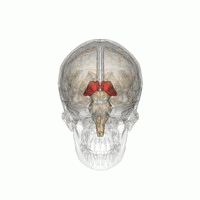Update:
Peter Klevius started as an empty
origo/singularity whose existencecentrism (mind) now is the sum of his
experience with his surroundings and due synaptic adaptations, while
also constituting part of the surroundings of others. A canvas which
doesn't have a soul/self of its own but does reflect what it has
experienced and adapted to. However, the false impression of having a
"self", "free will" etc. rests on language, i.e. the use of the word 'I'
which animals and humans without language lack. As a human with
language you are in the same position as Peter Klevius, and together we
all (incl. non-language humans) make up the total existencecentrism of
humankind - and the key to a universal human with (negative) Human
Rights without irrational exceptions and impositions. So when Peter
Klevius talks/writes/acts, he does so against a background that includes
the latest synapses combinations in his brain as well as what his other
nerve signals bring to his thalamus from his body and other
surroundings.
Peter
Klevius (1981, 1992): The ultimate question ought to be: What is it
like to be a stone? There's no difference between human consciousness
polished through living, and the "consciousness" of a stone that has
been smoothly shaped in streaming water against other rocks, stones etc.
It started its "life" as a rugged piece of rock in a mountain and
adapted to its life in streaming water down hill, or perhaps as a piece
of rock falling on a beach and polished by waves.
How US robs the world

Update: Dear reader, do realize that Peter Klevius
is an intellectual coward who doesn't always dare to write down what he
thinks is obvious but too "offensive" against "established" science. So
Peter Klevius tried to keep something in Africa just tp avoid him being
seen as an attention seeking charlatan. However, it certainly didn't
help so now he has tried to suppress this awful "playing with the rules
of the game" - much because he has realized that his earler respect for
academic research has been hurtfully damaged. So when Peter Klevius in
old postings talk about chimps he really means apes coming out from
Eurasia/SE Asia.

The irrefutable art track in Northern Eurasia (see map below) has no contemporary equivalent in other parts of the world. Based on what we know now it had no fore bearers whatsoever in any period of time. Moreover, it seems that there was even a decline before "civilizations" started tens of thousands of years later! Yet Klevius seems to be the only one addressing this most interesting (besides genetics) fact! According to Klevius (and no one else so far) the new and more efficient brain evolved in a jungle environment (SE Asia?) and spread up until meeting with big headed Neanderthals hence creating the modern human who later spread and dissolved with archaic homos. In this process Homo erectus was most probably involved as well.
Updated info about the origin of Klevius' theory
Keep in mind that mainland SE Asia possibly harbored physically truly modern humans already before the time range (12,000/18,000 ybp - 98,000 ybp) of the Homo floresiensis remains in the Flores cave.
Liujiang, SE China (est. 100,000-140,000ybp)
If this Liujiang skull had been found in Africa or Mideast Wikipedia and other media would be overfilled. But this is all you get now (summer 2015 update) from Wikipedia about this extremely important skull:
UPDATE: Research published April 2024 dates Liujiang as contemporary with the more archaic looking Cro-Magnon, which makes sense considering Cro-Magnon genes had to "wade" (hybridize) through a vast Neanderthal land on their path from East to West.
The Liujiang skull probably came from sediment dating to 111 000 to 139 000 which would mean it's older than the oldest Homo floresiensis remains on Flores. Nothing even remotely close to this modern skull has ever been found in Africa, Mideast or Europe this early. In other words, we have the extremely archaic looking Red Deer Cave people 100,000 years
after this extremely modern looking Liujiang population at approximately the same region. Even the least probable estimate of 70,000 bp would make Liujiang more modern looking than anything else.
Also compare Lake Mungo remains in Australia with an mtDNA that differs completely from ours (incl. Australian Aborigines). Sadly the remains have been kept out of further research because of stupid* "Aboriginal"(?!) greed (for the purpose of making certain people more "special" than others for no good reason at all (also compare the ridiculous Kennewick man controversy). Does it need to be said that the Mungo remains are as far from Australian Aborigines in appearance as you can imagine. However, according to Alan Thorne, 'Mungo could not have come from Africa as, just like Aboriginal Australians don't look like anybody from Africa, Mungo Man's skeleton doesn't look like anybody from Africa either. LM3 skeleton was of a gracile individual, estimated stature of 196 cm, which all sharply contrast with the morphology of modern indigenous Australians. Compared to the older Liujiang skull Mungo man had a much smaller brain.
* There's no way anyone can state who was "first" in Australia - and even if there was, then there's still no way of making any meaningful connection to now living people. The British atrocities against the extant natives in Australia is a completely different, although extremely important, issue - like the one of earlier atrocities by s.c. Aboriginals against earlier "negritos" in Australia.
In Demand for Resources (1992:28 ISBN 9173288411) in a chapter about human evolution, Peter Klevius used only one example, the remarkable Jinniushan skeleton/cranium:
In northern China near North Korean border an almost complete skeleton of a young man who died 280,000 years ago. The skeleton was remarkable because its big cranial volume (1,400cc) was not expected in Homo erectus territory at this early time and even if classified as Homo sapiens it was still big. The anatomically completely modern human brain volume is 1,400 cc and appeared between 50-100,000 years ago. One may therefore conclude that big brain volume by far predated more sophisticated human behavior (Klevius 1992:28).
Today, when many believe the skeleton is female, the brain size becomes even more remarkable.
Updated map
Peter Klevius 1992-2010: From tropical SE-Asia to cold and protein/fat rich North Eurasia to global humans. In Demand for Resources (1992
ISBN 9173288411) Klevius not only set the foundation of the so far best
theory on consciousness and how the brain works (see e.g. the "stone" example pp 31-33, or the 1994 EMAH paper that was sent to Francis Crick ), but also connected the
big brained 280,000 bp Jinniushan in northern China with the mongoloid
features of the oldest Africans - and asked: Why didn't Jinniushan
people go to the Moon, after all, they had several iceages time to do
so with a brain size exceeding modern humans. In 2004, after the
discovery of Homo floresiensis Klevius immediately told the world that
here was the "missing brain link". When six years later Denisovan was
found, Klevius theory was proven correct in everything except lesser details.
Most "mysteries" in genetics disappear by abandoning OOA and changing direction of HSS evolution. Only South East Asia offered a combination of tropical island/mainland fluctuations needed to put pressure on size reduction paired with evolutionary isolation in an environment where only those survived who managed to shrink their heads while keeping the same intelligence as their mainland kins with some double the sized brain. Homo floresiensis is evidence that such has happened there.
Denisovan is an extinct species of human in the genus Homo. In March 2010, scientists announced the discovery of a finger bone fragment of a juvenile female who lived about 41,000 years ago, found in the remote Denisova Cave in the Altai Mountains in Siberia, a cave which has also been inhabited by Neanderthals and modern humans. Two teeth and a toe bone belonging to different members of the same population have since been reported.
Analysis of the mitochondrial DNA (mtDNA) of the Denisovan finger bone showed it to be genetically distinct from the mtDNAs of Neanderthals and modern humans. Subsequent study of the nuclear genome from this specimen suggests that this group shares a common origin with Neanderthals, that they ranged from Siberia to Southeast Asia, and that they lived among and interbred with the ancestors of some present-day modern humans, with about 3% to 5% of the DNA of Melanesians and Aboriginal Australians deriving from Denisovans. DNA discovered in Spain suggests that Denisovans at some point resided in Western Europe, where Neanderthals were thought to be the only inhabitants. A comparison with the genome of a Neanderthal from the same cave revealed significant local interbreeding, with local Neanderthal DNA representing 17% of the Denisovan genome, while evidence was also detected of interbreeding with an as yet unidentified ancient human lineage. Similar analysis of a toe bone discovered in 2011 is underway, while analysis of DNA from two teeth found in layers different from the finger bone revealed an unexpected degree of mtDNA divergence among Denisovans. In 2013, mitochondrial DNA from a 400,000-year-old hominin femur bone from Spain, which had been seen as either Neanderthal or Homo heidelbergensis, was found to be closer to Denisovan mtDNA than to Neanderthal mtDNA.
Little is known of the precise anatomical features of the Denisovans, since the only physical remains discovered thus far are the finger bone, two teeth from which genetic material has been gathered and a toe bone. The single finger bone is unusually broad and robust, well outside the variation seen in modern people. Surprisingly, it belonged to a female, indicating that the Denisovans were extremely robust, perhaps similar in build to the Neanderthals. The tooth that has been characterized shares no derived morphological features with Neanderthal or modern humans. An initial morphological characterization of the toe bone led to the suggestion that it may have belonged to a Neanderthal-Denisovan hybrid individual, although a critic suggested that the morphology was inconclusive. This toe bone's DNA was analyzed by Pääbo. After looking at the full genome, Pääbo and others confirmed that humans produced hybrids with Denisovans.
Some older finds may or may not belong to the Denisovan line. These includes the skulls from Dali and Maba, and a number of more fragmentary remains from Asia. Asia is not well mapped with regard to human evolution, and the above finds may represent a group of "Asian Neanderthals".
Jinniushan and Floresiensis - the keys to Denisovan and the truly modern humans
Jinniushan had a bigger brain than anything in contemporary Africa
In
Demand for Resources (1992:28 ISBN 9173288411) in a chapter
about human evolution, Peter Klevius used only one example, the
remarkable Jinniushan skeleton/cranium:
In northern China near North Korean
border an almost complete skeleton of a young man who died 280,000
years ago. The skeleton was remarkable because its big cranial volume
(1,400cc) was not expected in Homo erectus territory at this early time
and even if classified as Homo sapiens it was still big. The
anatomically completely modern human brain volume is 1,400 cc and
appeared between 50-100,000 years ago. One may therefore conclude that
big brain volume by far predated more sophisticated human behavior
(Klevius 1992:28).
Today, when many believe the skeleton is female, the brain size becomes even more remarkable.
Since 1991 when Klevius wrote his book much new information has been
produced. However, it seems that the Jinniushan archaic Homo sapiens
still constitutes the most spectacular anomaly (together with Homo
floresiensis) in anthropology. So why did Klevius pick Jinniushan
instead of one of the more fashionable human remains? After all, Klevius
was a big fan of Rchard Leakey (he even interviewed him in a lengthy
program for the Finnish YLE broadcasting company) and there was a lot of
exciting bones appearing from the Rift Valley.
In the 1980s Klevius paid special attention to Australian aborigines and
African "bushmen" and noted that the latter were mongoloid in
appearance (even more so considering that todays Khoe-San/Khoisan are
heavily mixed with Bantu speakers). But mongoloid features are due to
cold adaptation in the north and therefore the "bushmen" had to be
related to Eurasia. Klevius soon realized that the Khoisan speakers had
moved to the southern Africa quite recently as a consequence of the so
called Bantu expansion. More studies indicated that the "bushmen" had
previously populated most of east Africa up to the Red Sea and beyond.
So the next step for Klevius was to search for early big skulled human
remains in the mongoloid northern part of Eurasia. And that search
really paid off.
This happened more than 20 years before the discovery of the Denisova bracelet and the human relative Denisovan in Altai.
Klevius book Demand for Resources (1992) in which these thoughts about
mongoloid traits were published also predates Floresiensis with more
than a decade.
Both fossils show clear cold adaptation (mongoloid) traits. However,
Jinniushan (right) is older and has a bigger cranial capacity although
it's female.
Peter Brown (world famous for discovering/defending Floresiensis in 2004
and who had big trouble getting his PhD accepted because of a biased
supervisor/institution): What makes Dali, as well as Jinniushan (Lu,
1989; Wu, 1988a), particularly important is that both of their facial
skeletons are reasonably complete. This is an unusual situation in China
as the only other middle Pleistocene hominids to have faces in China
are the Yunxian Homo erectus (Li and Etler, 1992), which are both very
distorted. Originating in the pioneering research of Weidenreich (1939a,
1939b, 1943) at Zhoukoudian, there has been strong support by Chinese
Palaeoanthropologists for evolutionary continuity between Chinese H.
erectus and modern humans in China. It has been argued that this is most
clearly expressed in the architecture of the facial skeleton (Wolpoff
et al., 1984). East Asian traits have been argued to include lack of
anterior facial projection, angulation in the zygomatic process of the
maxilla and anterior orientation of the frontal process, pronounced
frontal orientation of the malar faces, and facial flatness. While some
of these traits may occur at high frequency in modern East Asians (cf
Lahr, 1996) they are not present in late Pleistocene East Asians, for
instance Upper Cave 101 and Liujiang (Brown, 1999), or more apparent in
Dali and Jinniushan than archaic H. sapiens from Africa or Europe.
Recently there has been a tendency to link a group of Chinese hominin
fossils, including Dali, Maba, Xujiayao, and Jinniushan, previously
considered by some researchers to be "archaic Homo sapiens", with the
Denisovians (Reich et al. 2010; Martinón-Torres et al. 2011)
(http://www.nature.com/nature/journal/v468/n7327/full/nature09710.html).
However, apart from a few teeth, the Denisovians are only known from
palaeo DNA. There is also a great deal of anatomical variation in the
Chinese "archaic Homo sapiens" group. It will be interesting to see how
this plays out over the next decade, or so.
Klevius: It turns the conventional anthropological map on its head!
First and third from the left are Red Deer Cave people 14,300-11,500 years ago. Second and fourth the so called Venus from Brassempouy in France 25-26,000 years ago. The last pic is a reconstruction of a 1.9 Million year old Homo rudolfiensis skull. They all had flat broad cheeks, no chin and rounded forehead.
From the left: Red Deer Cave, Sami, Cro-Magnon
Was the sculptural portrait of Venus of Brassempouy made because she looked so different from Cro Magnon? Was she kept as a pet or something by her Cro Magnon captors?
There were certainly completely different looking modern humans living in Eurasia side by side some 26,000 years ago. And the only way to make sense of these enormous differences is Klevius hybridization theory, i.e. that the modern brain came from small ape-like creatures (compare the "scientists" who didn't believe that the small Homo floresiensis brain could be capable of tool-making, fire-making etc..
Debbie Martyr (an Orang Pendek* researcher): "the mouth is small and neat, the eyes are set wide apart and the nose is distinctly humanoid"
* Orange Pendek is the most common name given to a small but broad shouldered cryptid ceature that reportedly inhabits remote, mountainous forests on Sumatra.
Venus of Brassempouy, one of the world's oldest real portrait
(this one slightly retouched by Klevius)
The Red Deer Cave people, discovered in southern China and who lived some 14,300-11,500 years ago had long, broad and tall frontal lobes behind the forehead, which are associated with personality and behavior. However, they also express prominent brow ridges, thick skull bones, flat upper face with a broad nose, jutting jaws and lack a humanlike chin. Their brains were smaller than modern humans and they had large molar teeth (just like Denisovan), and short parietal lobes at the top of the head (associated with sensory data). According to Curnoe, "These are primitive features seen in our ancestors hundreds of thousands of years ago".
Unique features of the Red Deer Cave people include a strongly curved forehead bone, broad nose and broad eye sockets, flat and wide cheeks and wide and deep lower jaw joint to the skull base.
Klevius comment: Compare this description to Venus of Brassempouy on the pic, one of the world’s oldest portrait/sculpture of a human made some 25-26,000 years ago in what is now France.

This Cro Magnon could have been the captor of Venus of Brassempouy. Compare e.g. his protruding chin with the retracting one on Venus of Brassempouy. And keep in mind that the human chin has been an elusive and quite recent feature in human evolution. The delicate features we used to attribute to anatomically modern human while simultaneously attributing high intelligence may, in fact, not be connected at all. Slender and delicate skeletal features are not always connected with high cultural achievement. Quite the opposite when looking at skeletal remains outside the Aurignacian area..
In Dolní Věstonice, Eastern Europe a portrait of an almost modern Cro Magnon is now scientifically dated to at least 29,000 BP. The performance of its creator is on an extremely high cultural level when considering it predates Mideastern civilizations with some23,000 years, and that it evolved in a cultural tradition that has never been found in Africa or Mideast.
Klevius comment: Consider the circumstances. Small population and, at some stage, no previous "teachers". This northern part of the Aurignacian struck almost out of the blue unles you also consider the Denisova bracelet.
This extremely complicated to manufacture stone bracelet was made by the ape-like "non-human(?) Denisovan hybrid in Siberia >40,000 years ago by utilizing a drilling technology, comparable to modern machines, according to the researchers who found it.
Professor Ji Xueping ( Yunnan Institute of Cultural Relics and Archeology): “Because of the geographical diversity caused by the Qinghai-Tibet plateau, south-west China is well known as a biodiversity hotspot and for its great cultural diversity”.
Klevius comment: Compare what was said already 2004 (before the presentation of Homo floresiensis) on the web(and 1992 in book form): Genes were "pumped" back and forth through mostly the same (Central-Asian) geographical "veins" by frequent climate changes, hence prohibiting speciation but encouraging local "raciation".
According to Klevius' theory we got our modern brain intelligence from hybridization with apes (Pan?). These creatures were small and apelike although bipedal. When they moved north they encountered cold adapted Homos with large skulls. This combination created the most intelligent people ever on the planet. However, when this extremely small population began expanding it dissolved with the big headed but stupid Homos hence empowering their intelligence while diluting its own. The mix became today's humans.
Homo floresiensis on Java (i.e. north of the Wallace line as opposed to thise found on Flores) may be, and the Denisovans in Siberia are variants on this hybrid path.
"Racial" distribution in accordance with Klevius' "Out of Siberia and back to Africa" theory (aka "Out of Africa as pygmies and back as global mongoloids"
Mongoloids and Australoids are the races most distant from each other because whereas Africa had a strong back migration of mongoloids Australia due to its location came to be less involved. This is also why the so called Caucasoid race (in a broad sense) came to populate what in Klevius terminology is called the "bastard belt" (the grey area on the map).
The senseless Mideastern "creation out of nothing" ideology got popular only because it boosted patriarchal sex apartheid (Adam created by "god" and woman created from Adam).
The incredibly stupid (see postings below) "Out of Africa" term only competes with the equally misleading and stupid "Big Bang" term - see
Klevius new blog on the Origin of Universe (note that there's no 'the' in front of universe).
M130
Genetic traces of Denisovan
Klevius' human evolution formula from hot to cold
Chimp(i.e. ape*)/Homo hybridization (FOXP2 variant) + meeting/mixing with Eurasian Homos = Denisovan (Floresiensis?) and leaves an early but misleading genetic Africa label due to the back and forth movement between Eurasia and Africa.
* Update clarification: Genes in modern chimps/great apes aren't connected to Africa no more than mongoloid (cold adaption) traits in Homo species. FOXP2 exists in all mammals but the human variant is unique.
Denisovan (Floresiensis?) gets a better packed brain in island Indonesia through sea level isolation. Later on the opposite effect releases some of them into Asian mainland.
In summary, the oldest African genes are not human, and the later ones are just the result of mixing from back migration.
When Klevius in the 1980s got in contact with African aborigines he immediately was struck by their mongoloid appearance. Why on earth would African aborigines have traces of cold adaptation? Today we have the answer in Siberia.

















































































































































































